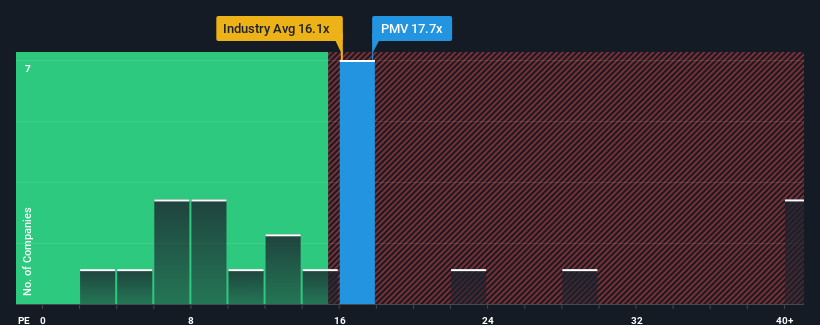- Australia
- /
- Specialty Stores
- /
- ASX:PMV
Risks To Shareholder Returns Are Elevated At These Prices For Premier Investments Limited (ASX:PMV)

With a median price-to-earnings (or "P/E") ratio of close to 19x in Australia, you could be forgiven for feeling indifferent about Premier Investments Limited's (ASX:PMV) P/E ratio of 17.7x. However, investors might be overlooking a clear opportunity or potential setback if there is no rational basis for the P/E.
Premier Investments has been struggling lately as its earnings have declined faster than most other companies. One possibility is that the P/E is moderate because investors think the company's earnings trend will eventually fall in line with most others in the market. You'd much rather the company wasn't bleeding earnings if you still believe in the business. If not, then existing shareholders may be a little nervous about the viability of the share price.
View our latest analysis for Premier Investments

Does Growth Match The P/E?
Premier Investments' P/E ratio would be typical for a company that's only expected to deliver moderate growth, and importantly, perform in line with the market.
If we review the last year of earnings, dishearteningly the company's profits fell to the tune of 7.5%. That put a dampener on the good run it was having over the longer-term as its three-year EPS growth is still a noteworthy 20% in total. Accordingly, while they would have preferred to keep the run going, shareholders would be roughly satisfied with the medium-term rates of earnings growth.
Turning to the outlook, the next three years should generate growth of 0.3% each year as estimated by the eleven analysts watching the company. That's shaping up to be materially lower than the 17% per annum growth forecast for the broader market.
With this information, we find it interesting that Premier Investments is trading at a fairly similar P/E to the market. Apparently many investors in the company are less bearish than analysts indicate and aren't willing to let go of their stock right now. These shareholders may be setting themselves up for future disappointment if the P/E falls to levels more in line with the growth outlook.
What We Can Learn From Premier Investments' P/E?
We'd say the price-to-earnings ratio's power isn't primarily as a valuation instrument but rather to gauge current investor sentiment and future expectations.
Our examination of Premier Investments' analyst forecasts revealed that its inferior earnings outlook isn't impacting its P/E as much as we would have predicted. When we see a weak earnings outlook with slower than market growth, we suspect the share price is at risk of declining, sending the moderate P/E lower. This places shareholders' investments at risk and potential investors in danger of paying an unnecessary premium.
Many other vital risk factors can be found on the company's balance sheet. Our free balance sheet analysis for Premier Investments with six simple checks will allow you to discover any risks that could be an issue.
If these risks are making you reconsider your opinion on Premier Investments, explore our interactive list of high quality stocks to get an idea of what else is out there.
New: Manage All Your Stock Portfolios in One Place
We've created the ultimate portfolio companion for stock investors, and it's free.
• Connect an unlimited number of Portfolios and see your total in one currency
• Be alerted to new Warning Signs or Risks via email or mobile
• Track the Fair Value of your stocks
Have feedback on this article? Concerned about the content? Get in touch with us directly. Alternatively, email editorial-team (at) simplywallst.com.
This article by Simply Wall St is general in nature. We provide commentary based on historical data and analyst forecasts only using an unbiased methodology and our articles are not intended to be financial advice. It does not constitute a recommendation to buy or sell any stock, and does not take account of your objectives, or your financial situation. We aim to bring you long-term focused analysis driven by fundamental data. Note that our analysis may not factor in the latest price-sensitive company announcements or qualitative material. Simply Wall St has no position in any stocks mentioned.
About ASX:PMV
Premier Investments
Operates various specialty retail fashion chains in Australia, New Zealand, Asia, and Europe.
Flawless balance sheet established dividend payer.
Similar Companies
Market Insights
Community Narratives




